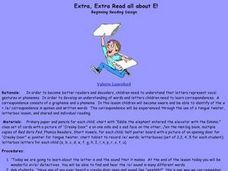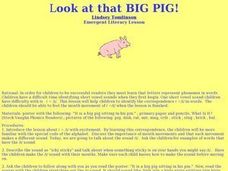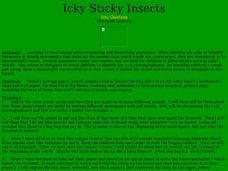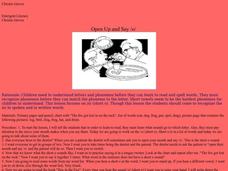Curated OER
Aaa, Alligators!!!
Students are introduced to different words that have the /a/ sound in them. They think of their own words that contain the sound and practice making the letter "a" on primary writing paper. Students who have formed the letter correctly...
Curated OER
Extra, Extra Read all about E!
Pupils examine the letter 'e'. Through instruction and modeling they explore the sound the letter makes, how the letter is written, etc. They recite tongue twisters and use letterboxes to write 'e' words. They pick out short /e/ words...
Curated OER
Look at that BIG PIG!!!
First graders give examples of words that have the /i/ sound. They make the /i/ sound with their mouths and follow along as the poster is read which contains /i/ words. They read the poster together stretching out the /i/ sound and...
Curated OER
Language Arts: Sound Recognition
First graders practice the short i sound by repeating tongue twisters. Later they write the letter i by using the analogy of drawing a straight line from the "fence" down to the "sidewalk" and putting a "basketball" above it. Other...
Curated OER
Build it Up
First graders practice spelling words through by blending sounds with a focus on short vowels i and a. Through matching and listening activities, 1st graders replace initial and final sounds to create words they decode and read.
Curated OER
Icky Icky I
First graders review the letter "i" and use popsicle sticks and cotton balls to make upper and lower case "i's". Volunteers make the capital and lower case "i" on the board and then the class discovers the short sound that letter "i"...
Curated OER
Itchy Iggy
First graders observe the letter /i/ and the sound that it makes watching their mouths as the sound is formed. They say the tongue twister displayed repeating it three times; the last time they stretch out the /i/ sound as it occurs in...
Curated OER
Open Wide at the Dentist, "Aaaahh"
Study the /o/ in both written and spoken words by reciting a tongue twister and making words using Elkonin letterboxes. Next, write a message about frogs using /o/ words. Finally, listen to a short book talk on "Doc in the Fog" before...
Curated OER
What's Up Doc?
Students demonstrate the /o/ sound by opening up their mouth and saying, "Ahhhhh". They try saying a tongue twister that contains the /o/ phoneme; repeating it two times together. They then practice writing the letter /o/ so that it can...
Curated OER
Let's Read and Read!
Pupils discover how to hold their mouths to form the /o/ sound and that it may be hidden in different words. They say /o/ and then repeat a tongue twister that contains many /o/ words and practice writing it on primary lined paper. They...
Curated OER
Bless You
Students practice recognizing the phoneme /a/ in spoken and written words as well as by symbol. They interact with the book, "The Cat Nap," from Educational Insights and the Dr. Seuss book, "ABC's Book." Each student also plays a memory...
Curated OER
Icky Sticky Insects
Students discuss that words are made up of many different sounds. They make the /i/ sound pretending to see a big bug. They read a tongue twister that has several words with the same phoneme and stretch out the /i/ sound at the beginning...
Curated OER
AAAAAAAAAAA! Stop Crying!
Students practice recognizing the phoneme /a/ in spoken words. They interact with the book, "A Cat's Nap," and a poster with Abby and Allen on it that are asking animals for apples, and cards with words on them like at, mad, went, bag,...
Curated OER
Segmenting and Blending Words
Students are introduced to the concept of segmentation and blending of words. As a class, they are shown various words and are asked to determine the amount of letters and sounds in each. To end the lesson, they participate in a...
Curated OER
"Ca...Ca...Ca...Caterpillar Blending"
Students improve blending skills. They produce many individual short utterances and mouth moves (phonemes) into one long utterance (words) and create their own blending caterpillar. They draw a picture of a caterpillar with three...
Curated OER
Open Up and Say /o/
Young scholars explore letters and phonemes. They discuss the phoneme /o/. Students recognize /o/ in both spoken and written words. They discuss the shape their mouths make when saying /o/. Young scholars learn a tongue twister to help...
Pennsylvania Department of Education
What's My Sound?
Students follow a power point presentation to practice the sounds each letter of the alphabet make. In this 'what's my sound' activity, students apply word recognition strategies and demonstrate listening and comprehension skills to...
Curated OER
Open Wide
First graders make the sound of /o/ relating it to the sound they make when the doctor asks them to open their mouth and say "ahhhh". They think of different words that contain the /o/ and identify it as it is used in a sentence and...
Curated OER
What's Behind the Creaky Door?
First graders are introduced to the concept that letters stand for the mouth moves that we make when sounds are made. They practice making the /e/ sound and compare it to the sound a creaky door makes and then try saying the tongue...
Curated OER
Alphabet
Students state the letters of the alphabet individually and in new words. In this alphabet lesson plan, students use the alphabet in a variety of ways during reading.
Curated OER
Doo-Wop Pop
Doo-Wop Pop, by Roni Schotter is story that focuses on music and performing arts. Language arts activities include phonics, music, writing about dreams, poetry, and writing a letter are included in this literature guide. Furthermore...
Meadows Center for Preventing Educational Risk, University of Texas at Austin
Lesson 8 - Open Syllables
Just like scholars plug something in to close a circuit, they must plug a consonant onto a word to make closed syllables. Help learners distinguish between open and closed syllables with a series of activities that emphasize open...
Curated OER
Rainbow Spelling: A Kinesthetic Approach to Encoding
Have your young learners interact with phonemes through this tactile plan! Each learner will have a colored mat where they connect different phonemes to create words. The best part is that they can self-correct easily as they spell!
Curated OER
Open Wide
Students recognize the short vowel o in written and spoken language. Through matching activities, students discriminate the short vowel o from the long vowel o. They associate the phoneme with its letter representation and identify the...

























